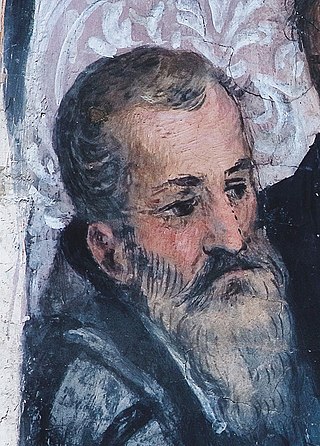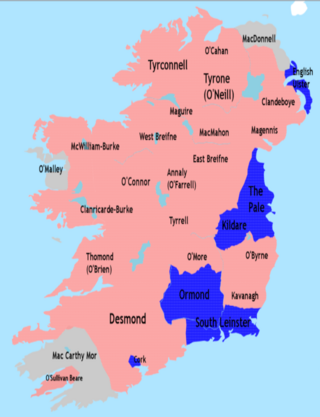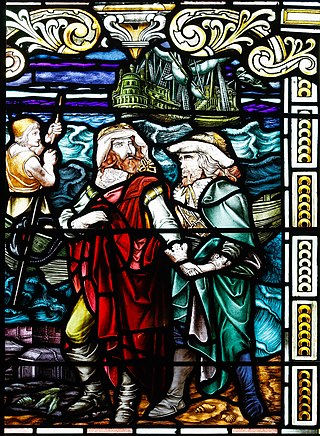Related Research Articles

Hugh O'Neill, Earl of Tyrone was an Irish Gaelic lord and key figure of the Nine Years' War. Known as the "Great Earl", he led the confederacy of Irish clans against the English Crown in resistance to the Tudor conquest of Ireland under Queen Elizabeth I.
Niall Garve O'Donnell was an Irish nobleman and soldier, alternately a rebel against and ally of English rule in Ireland. He is best known for siding with the English against his kinsman Hugh Roe O'Donnell during the Nine Years' War.

The O'Cahan were a powerful sept of the Northern Uí Néill's Cenél nEógain in medieval Ireland. The name is presently anglicized as O'Kane, Kane and Keane.

The Flight of the Earls took place in September 1607, when Hugh O'Neill, Earl of Tyrone, and Rory O'Donnell, 1st Earl of Tyrconnell, and about ninety followers, left Ulster in Ireland for mainland Europe. Their permanent exile was a watershed event in Irish history, symbolizing the end of the old Gaelic order.

Rory O'Donnell, 1st Earl of Tyrconnell, was an Irish Gaelic lord and the last King of Tyrconnell prior to the Plantation of Ulster. He succeeded his older brother Hugh Roe O'Donnell and in 1603 became the first to be styled the Earl of Tyrconnell. In 1607, following their defeat in the Nine Years' War, Tyrconnell and his wartime ally Tyrone fled Ireland for mainland Europe. Tyrconnell died of a fever shortly after settling in Rome.

The Nine Years' War, sometimes called Tyrone's Rebellion, took place in Ireland from 1593 to 1603. It was fought between an Irish confederacy—led mainly by Hugh O'Neill of Tyrone and Hugh Roe O'Donnell of Tyrconnell—against English rule in Ireland, and was a response to the ongoing Tudor conquest of Ireland. The war began in Ulster and northern Connacht, but eventually engulfed the entire island. The Irish alliance won numerous victories against the English forces in Ireland, such as the Battle of Clontibret (1595) and the Battle of the Yellow Ford (1598), but the English won a pivotal victory against the alliance and their Spanish allies in the siege of Kinsale (1601–02). The war ended with the Treaty of Mellifont (1603). Many of the defeated northern lords left Ireland to seek support for a new uprising in the Flight of the Earls (1607), never to return. This marked the end of Gaelic Ireland and created the groundwork for the foundation of the Plantation of Ulster.

Hugh Maguire was an Irish nobleman and military commander who served in the Nine Years' War. As Chief of the Maguire clan and Lord of Fermanagh, he was the first of the Gaelic chiefs to openly rebel against Elizabeth I's conquest of Ireland.

Sir Cahir O'Doherty was the last Gaelic Chief of the Name of Clan O'Doherty and Lord of Inishowen, in what is now County Donegal. O'Doherty was a noted loyalist during Tyrone's Rebellion and became known as the Queen's O'Doherty for his service on the Crown's side during the fighting.

Lady Fiona MacDonald was a Scottish aristocrat and queen consort of Tyrconnell. She is better known by her nickname Iníon Dubh, pronounced in Ulster Irish and Scots Gaelic as in-NEEN DOO.
Lady Agnes Campbell was a Scottish noblewoman and queen consort of Tír Eoghain. She was the mother of Iníon Dubh.
Sir George Paulet (1553–1608), also known as Pawlett, Pawlet, or Powlet, was an English soldier and administrator. He served as governor of Derry in Ireland. His arrogant and insolent behaviour caused O'Doherty's Rebellion in 1608. Paulet was killed by the rebels during the Burning of Derry.
Sir Hugh McManus O'Donnell was an Irish Gaelic lord. He was The O'Donnell of his clan, and king of Tyrconnell in Tudor-era Ireland.

Henry Docwra, 1st Baron Docwra of Culmore, was a leading English-born soldier and statesman in early seventeenth-century Ireland. He is often called "the founder of Derry", due to his role in establishing the city.
Sir Cormac MacBaron O'Neill (d.1613) was an Irish soldier and landowner of the Elizabethan and early Stuart eras. He was part of the O'Neill dynasty, one of the most prominent Gaelic families in Ireland.
Sir Arthur O'Neill or Sir Art O'Neill was an Irish soldier and landowner. He was part of the O'Neill dynasty, which was the most powerful Gaelic family in Ireland at the time. He was the son of Turlough Luineach O'Neill, the head of the O'Neill dynasty until 1595. He was the second son of Turlough, but his eldest brother Henry O'Neill died in 1578. At times he had a strained relationship with his father, and offered his support to Turlough's rival Hugh O'Neill, Earl of Tyrone. When Tyrone succeeded Turlough as head of the O'Neills and began Tyrone's Rebellion, Arthur offered tacit support to his distant cousin.
Brian O'Neill, 2nd Baron Dungannon was an Irish aristocrat of the Elizabethan era. He was part of the O'Neill dynasty, a Gaelic family in Ulster.
Nuala O'Donnell was an Irish noblewoman of the O'Donnell dynasty who took part in the Flight of the Earls. She was known as "the Lady of the Piercing Wail".
Siobhán O'Neill, Countess of Tyrone, sometimes anglicised Joanna, Joan, or Judith, was a sixteenth-century Irish Gaelic noblewoman of the O'Donnell clan. She was the second wife of Hugh O'Neill, Earl of Tyrone, bearing him most of his children.
Rose O'Neill was a Gaelic Irish noblewoman and queen consort of Tyrconnell. She was the daughter of Hugh O'Neill and wife of "Red" Hugh Roe O'Donnell, the two leaders of the Irish confederacy during the Nine Years' War. Her marriage to O'Donnell was a deliberate move to unite the O'Neills and the O'Donnells, the two most powerful Irish clans of their day. She separated from O'Donnell in 1595 and their marriage formally ended the following year.
Hugh O'Neill, 4th Baron Dungannon was an Irish nobleman. He was the son and heir to Irish Gaelic lord Hugh O'Neill, Earl of Tyrone, though he predeceased his father. His title was attainted in 1608.
References
Citatoins
- 1 2 3 4 5 6 Newman 2019.
- 1 2 3 4 Bigger 1904, p. 159.
- ↑ Canny 1970, p. 8.
- ↑ Curl 1986, p. 20.
- 1 2 3 Bigger 1904, p. 160.
- 1 2 3 4 5 6 Clavin, Terry (October 2009). "O'Cahan, Sir Donnell Ballach". Dictionary of Irish Biography . doi:10.3318/dib.006536.v1.
- 1 2 3 4 Walsh 1930, p. 38.
- 1 2 Walsh 1930, p. 37.
- 1 2 Morgan, Hiram (October 2009). "O'Donnell, 'Red' Hugh (Ó Domhnaill, Aodh Ruadh)". Dictionary of Irish Biography . doi:10.3318/dib.006343.v1 . Retrieved 10 June 2024.
- ↑ McGinty 2013, p. 44.
- ↑ Morgan, Hiram (September 2014). "O'Neill, Hugh". Dictionary of Irish Biography . doi:10.3318/dib.006962.v1 . Retrieved 10 June 2024.
- ↑ Dalton, G. F. (1974). "The Tradition of Blood Sacrifice to the Goddess Éire". Studies: An Irish Quarterly Review. 63 (252): 348–349. ISSN 0039-3495.
- ↑ McGurk, John (August 2007). "The Flight of the Earls: escape or strategic regrouping?". History Ireland . 15 (4). Archived from the original on 18 April 2024.
- ↑ Boyle 1989, p. x.
- ↑ Bigger 1904, p. 159–160.
- ↑ Hill 2004, p. 393.
- ↑ Curl 2009, p. 29.
Sources
- Bigger, F. J. (1904). "Sir Arthur Chichester, Lord Deputy of Ireland. With Some Notes on the Plantation of Ulster (Continued)". Ulster Journal of Archaeology. 10: 158–166.
- Boyle, E. M. (1989). Records of the Town of Limavady: 1609 to 1808. Limavady: North-West. ISBN 978-0-90752-815-9.
- Canny, N. P. (1970). "Hugh O'Neill, Earl of Tyrone, and the Changing Face of Gaelic Ulster". Studia Hibernica (10): 7–35.
- Curl, J. S. (1986). The Londonderry Plantation, 1609-1914: The History, Architecture, and Planning of the Estates of the City of London and Its Livery Companies in Ulster. Chichester: Phillimore. ISBN 978-0-85033-577-4.
- Curl, J. S. (2009). "Reluctant Colonisers: the City of London and the Plantation of Coleraine". History Ireland. 17: 28–31.
- Hill, G. (2004). The Conquest of Ireland : an Historical Account of the Plantation in Ulster at the Commencement of the Seventeenth Century. Belfast: Irish Genealogical Foundation. ISBN 978-0-94013-445-4.
- McGinty, Matthew (2013). "The Development and Dynamics of the Relationship between Hugh O'Neill and Red Hugh O'Donnell" .
- Newman, K. (2019). "Donnell Ballagh O'Cahan (-c.1626): Landowner". Dictionary of Ulster Biography. Archived from the original on 30 October 2019. Retrieved 30 October 2019.
- Walsh, Paul (1930). Walsh, Paul (ed.). THE WILL AND FAMILY OF HUGH O NEILL, EARL OF TYRONE [WITH AN APPENDIX OF GENEALOGIES] (PDF). Dublin: Sign of the Three Candles.
Further reading
- Pollard, Albert. . In Lee, Sidney (ed.). Dictionary of National Biography . Vol. 41. London: Smith, Elder & Co. pp. 344–345.